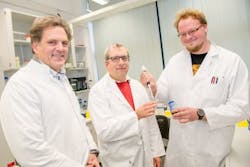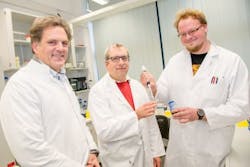Spectroscopy technique helps detail how important molecular switch works
A research team at Ruhr University Bochum (RUB; Germany) used Fourier transform infrared (FTIR) spectroscopy and computer simulations to analyze how GTPase-activating proteins switch off at the subatomic level. These proteins are involved in processes such as sight, smell, taste, and regulation of blood pressure.
Related: Super-resolution microscopy IDs molecular mechanism that drives immune response
If an enzyme cleaves a phosphate group from GTPase-activating proteins, the protein switch is turned off. This so-called GTP hydrolysis takes place within seconds and is activated by a specific amino acid, namely the arginine finger. If that process fails, the patient might develop a disease such as cholera. So, the RUB researchers have now succeeded in describing in detail how the arginine finger works, using a combination of methods from biology, theoretical physics, and experimental physics.
The time-resolved FTIR spectroscopy method the researchers used enables them to monitor enzymatic processes at a high temporal and spatial resolution in their natural state. However, the data thus measured do not provide any information about the precise location in the enzyme where a process is taking place. But by using quantum-mechanical computer simulations of structural models, the researchers were able to extract this information. "By combining theory and experiment, we thus gain a microscope with subatomic resolution," explains Klaus Gerwert, head of the Department of Biophysics at RUB and one of the leaders of the work.
Using this approach, the researchers found out in detail how GTP hydrolysis is accelerated--by rapidly turning off the proteins, it results in the arginine finger changing position. This result has great significance, as the enzymatic process of GTP hydrolysis as a molecular switch occurs frequently. The mechanisms of different switch processes in the body differ merely in details. GTP hydrolysis is, for example, also a switch for the Ras protein, the defects of which result in uncontrolled cellular growth in tumors.
"By cross-referencing the results of our analyses of various switch processes, we continue to bring new details of GTP hydrolysis to light," says Carsten Kötting, a private lecturer at RUB and co-leader of the research.
The researchers used spectroscopy to visualize the state of the arginine finger bonded to the GTP molecule at high precision, namely at one hundredth of the atomic diameter. The arginine finger has a considerable impact on the geometry and charge distribution of the bonding partner. "Our long-term aim is for our basic research to contribute to the development of drugs for the treatment of cancer and severe genetic diseases," explains Daniel Mann, a member of the research team.
Full details of the work appear in the Proceedings of the National Academy of Sciences; for more information, please visit http://dx.doi.org/10.1073/pnas.1612394113.

